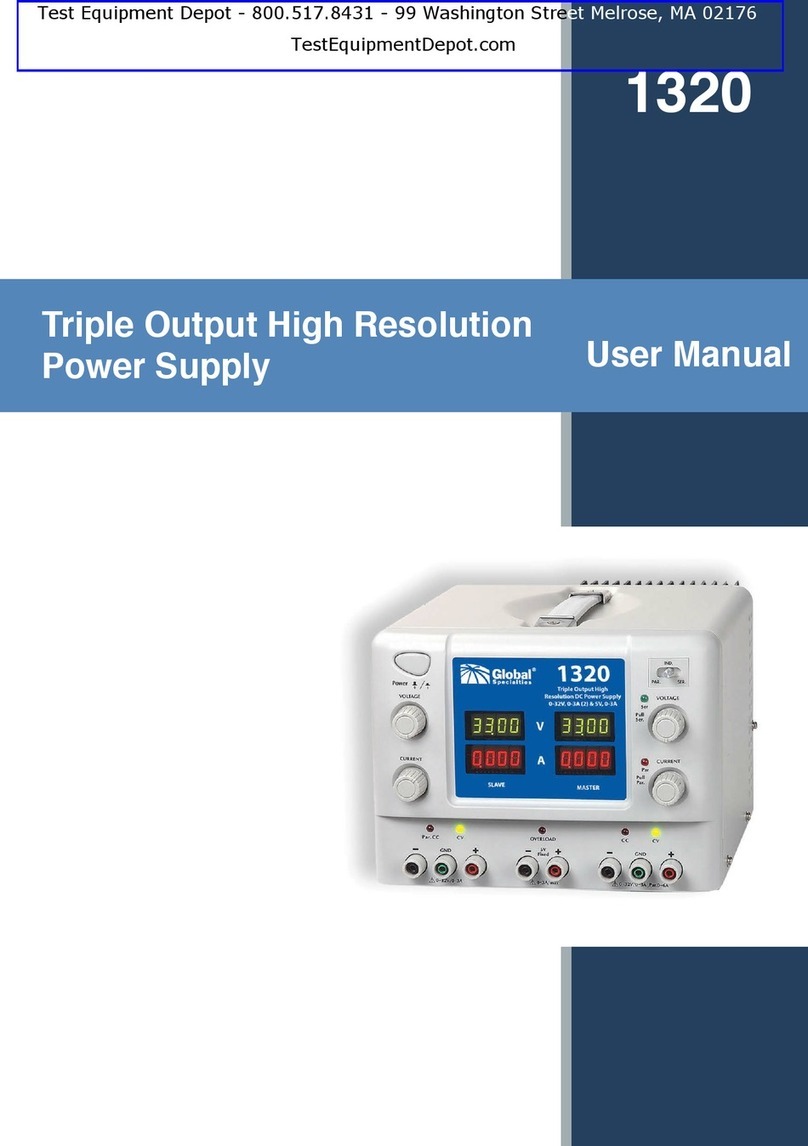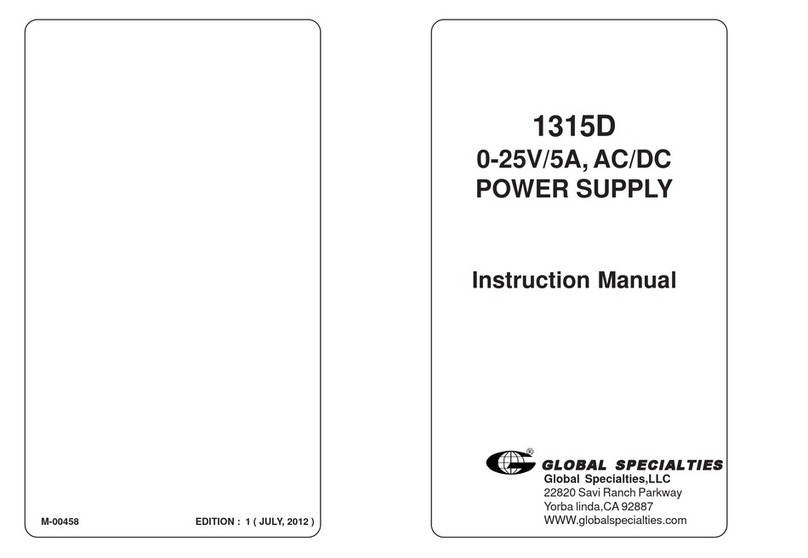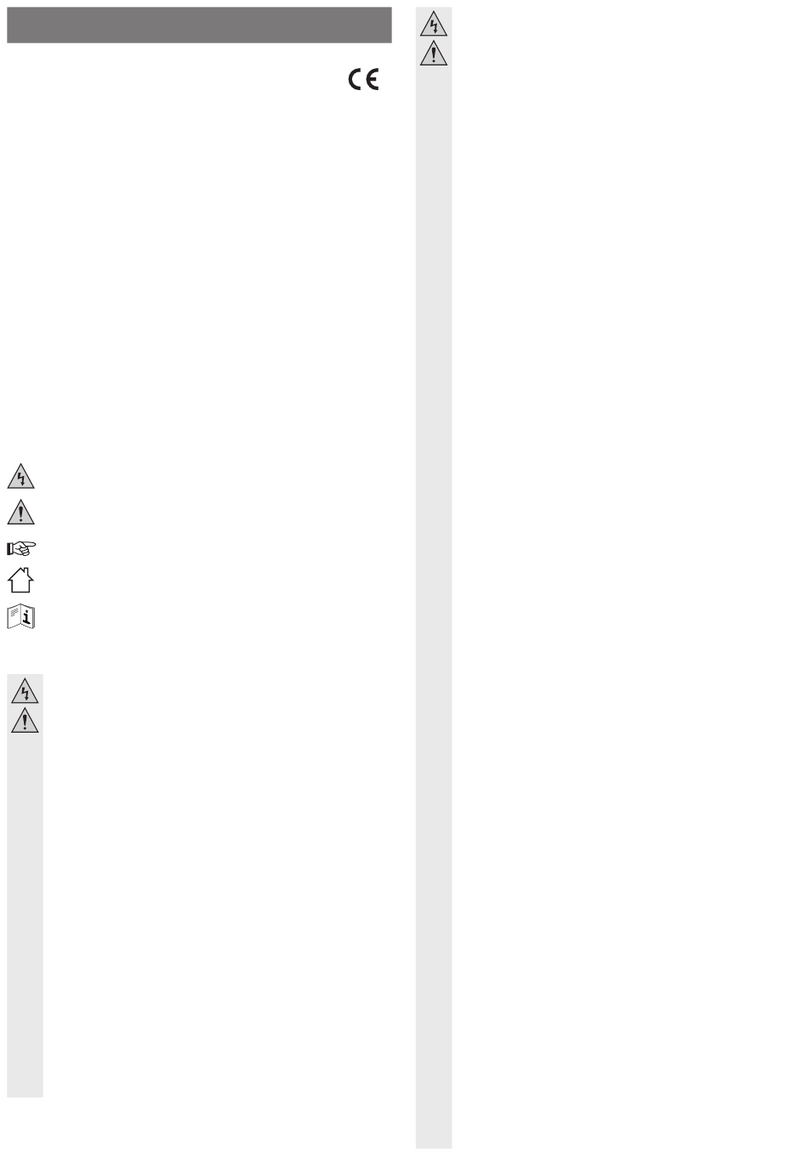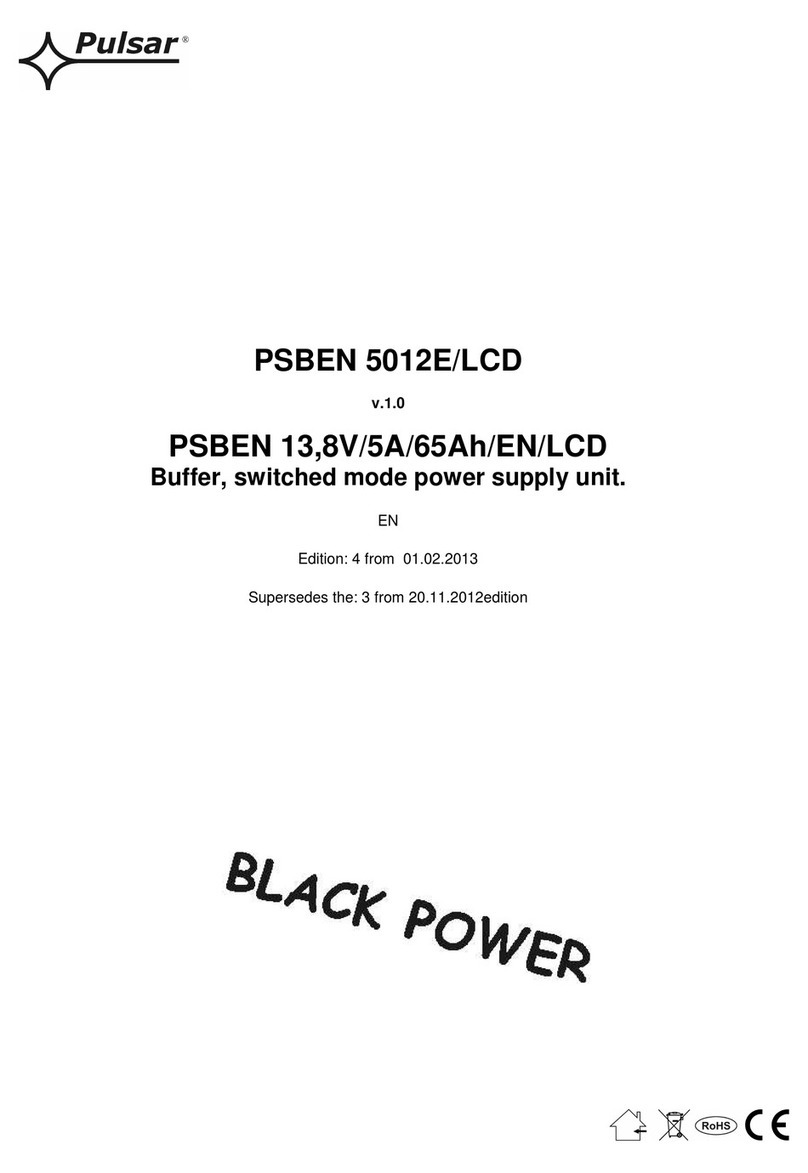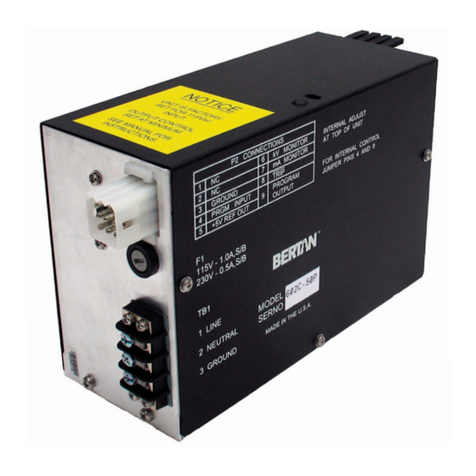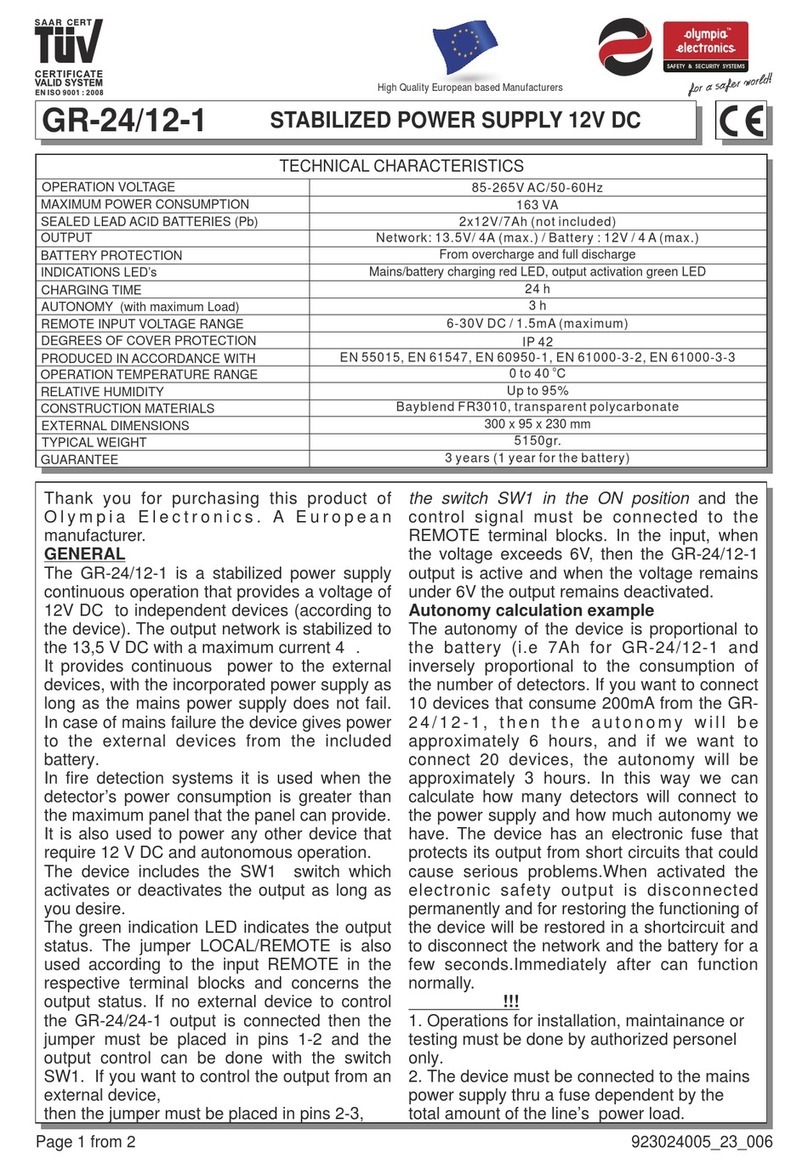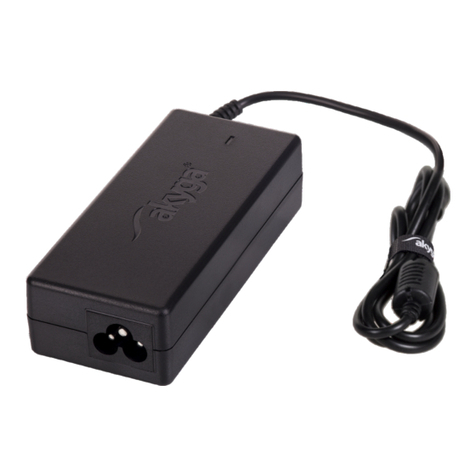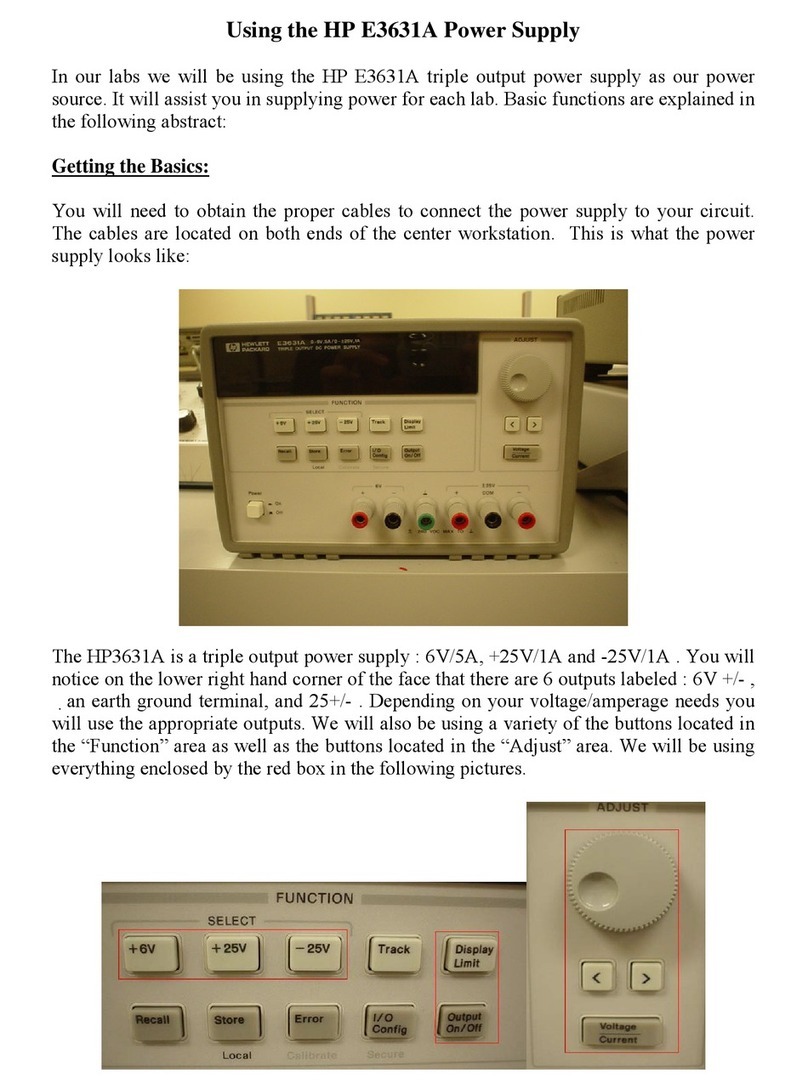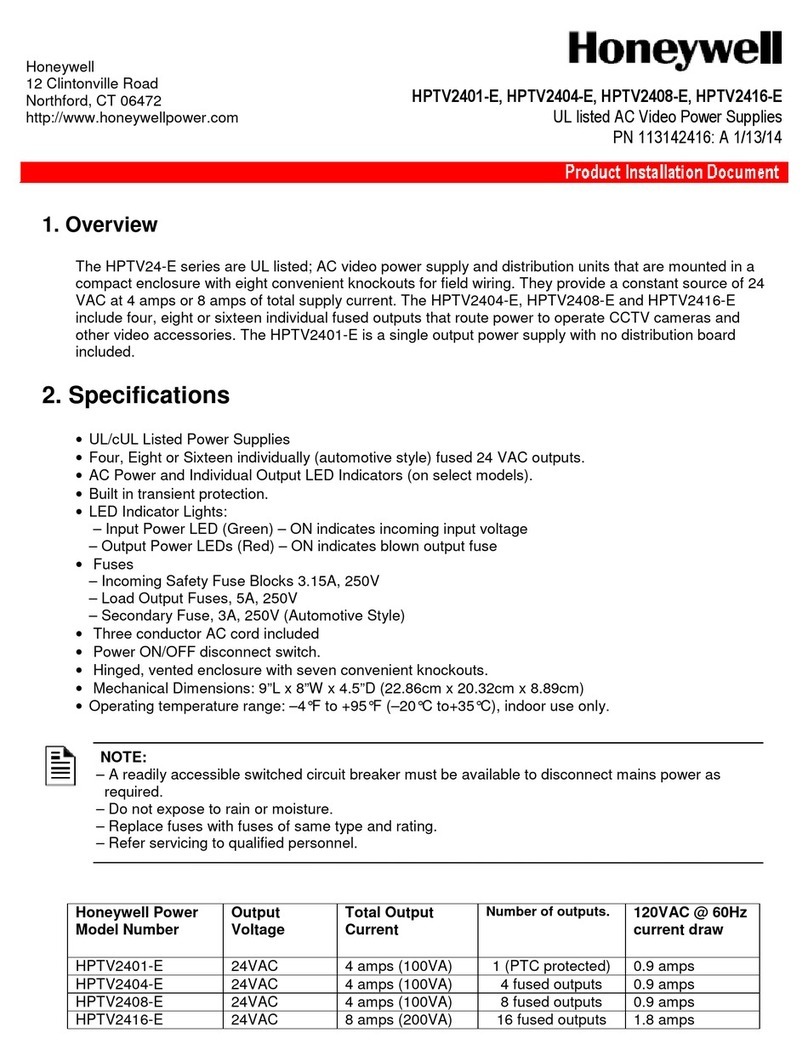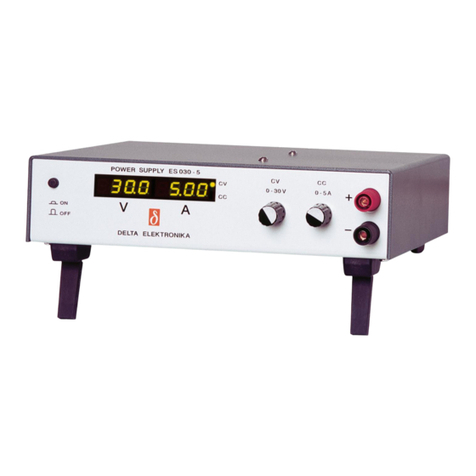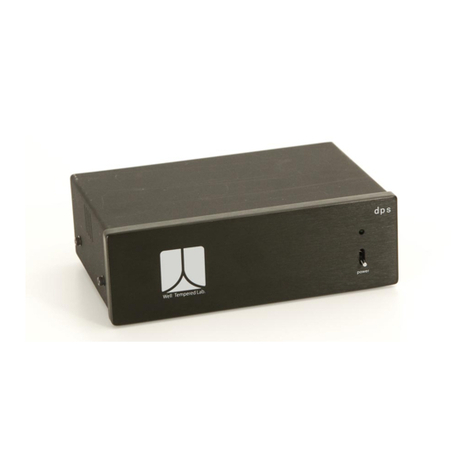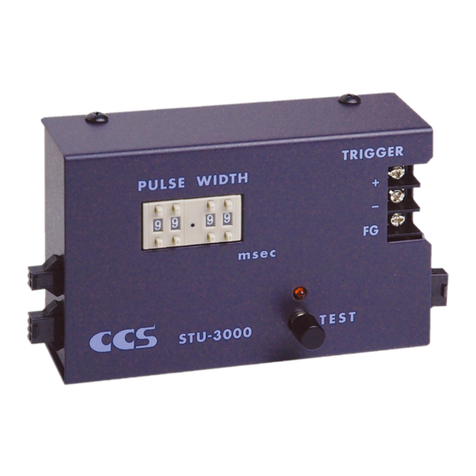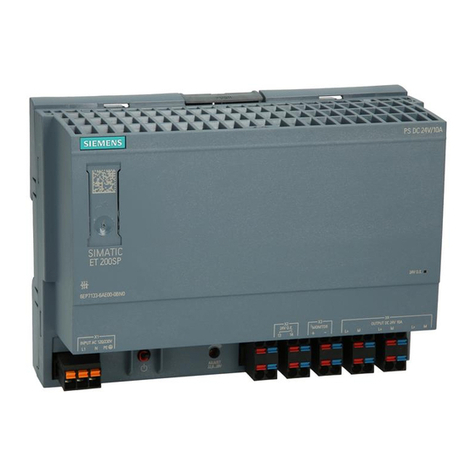Global Specialties 1310 User manual

1310
Revision: 01/2012
DC Power Supply
Instruction Manual

1310
DC POWER SUPPLY
Operation Manual
GLOBAL SPECIALTIES
22820 Savi Ranch Parkway
Yorba Linda, CA 92887
TEL.: (800) 572-1028
FAX.: (215) 830-7370
80-01-0538
S/90
M-00367 EDITION : 1 ( JAN., 2012 )

TABLE OF CONTENTS
SECTION DESCRIPTION PAGE NO.
1INTRODUCTION 1
2SPECIFICATIONS 2
3OPERATINGINSTRUCTIONS 4
4CIRCUITDESCRIPTION 11
5SERVICE & 13
WARRANTYINFORMATION
6MAINTENANCE & CALIBRATION 15
7PART LIST & SCHEMATICS 19

ABOUT GLOBAL SP ECIALTIES
Thank-you for selecting a GLOBAL SPECIALTIESproduct. You won’t
be disappointed ! Because we’ve never strayed from our original
founders’ simple ideal, lower the high cost of electronic design and
testing. Over the years, we’ve offered you electronic testing and
prottyping equipment that was engineered for the processinal, but
economically priced. The “best for less”, never compromising quality
in order to give you, our customer, a real value.
We accomplish our goal by cutting the industry giants down to size.
Most test equipment comes with excess features that you don’t want,
but have to pay for anyway. We eliminate these high cost features,
lower the price, but not the performance. The result is smarter tools for
the value minded user.
We pioneered the breadboarding industry allowing you to create circuits
as fast as you can think. Our breadboards are constructed to last. We
use high impact plastic and nickel silver contacts, plus “Made in U.S.A.”
quality and an unconditional lifetime guarantee. Our logic probes offer
speeds and storage capabilities only equaled by the fastest
oscilloscopes. When it comes to frequency counters we offer you far
more performance for far less money. Handheld or benchtop, frequency
counters or universal counter-timers, whatever you application you
can count on us. Our complete family of bench-top instruments offers
you features and performance unequaled, dollar for dollar.
In our continual strive for the “best for less” we never lose sight of the
future. We are always searching for ways to improve our existing
products and design new products using the latest technology. We do
this by asking you, our customers, what your needs are, and what your
likes and dislikes are. Feel free to contact us by phone, mail or fax with
your comments. Tell us how we can put Global to work for you.
In closing, we at GLOBAL SPECIALTIESwould like to express our
appreciation to our many loyal customers. We pledge to not rest on
our laurels nor will we forget our main objective, to supply the “best for
less”.
21
PCB Components 1310-PS-MAIN PCB
=======================================================================
Ref Designator Value
=======================================================================
DIODES
D5 1N751 ( 5.1V )
D17 1N4148
D18 1N4148
D25 1N4148
D26 1N4148
D1 1N4007
D2 1N4007
D3 1N4007
D4 1N4007
D10 1N4007
D111N4007
D13 1N4007
D14 1N4007
D15 1N4007
D16 1N4007
D19 1N4007
D20 1N4007
D21 1N4007
D22 1N4007
D23 1N4007
D24 1N4007
D27 1N4007
D28 1N4007
D6 1N5408
D7 1N5408
D8 1N5408
D9 1N5408
PCB Components 1310 DISPLAYPCB
=======================================================================
Ref Designator Value
=======================================================================
FNDs
FND1 RED FND COMM. ANNODE.
FND2 RED FND COMM. ANNODE.
FND3 RED FND COMM. ANNODE.

SECTION - 1
INTRODUCTION
POWER SUPPLY : MODEL1310
The 1310 Power Supply is a versatile triple-output unit which can
be used in both digital and analog circuit applications. It consists
of three independent power supplies: a foxed 5 volt supply rated at
1.0 amps maximum, and two variable 1.3 to 20 volt supplies each
rated at 250 milliamps maximum. The three digit display allows the
voltage of the variable supplies to be quickly and accurately set, and
current flow can be monitored with 1 milliamp resolution.
All three supplies are completely isolated from each other, and from
earth ground. A circuit or piece of equipment connected to any one
of the supplies may be floated to DC level different from the other
two supplies. In addition, any two - or all three - supplies may be
connected to the chassis and earth ground is provided. And, of
course, each supply is protected against short circuit and thermal
overloads.
The 1310 is an excellent general purpose power supply for
engineering lab applications, bread-boarding, and prototyping.
The triple-output voltages make it ideal for working with all
disciplines, from microcomputer components to op-amps. Priced
economically, the 1310 is the perfect choice for production lines,
service shops, hobbyists, and whenever a compact, reliable DC
power supply is needed.
120
PCB Components 1310-PS-MAIN PCB
=======================================================================
Ref Designator Value
=======================================================================
CAPACITORS
C1 22µF, 50V, ELE
C2 22µF, 50V, ELE
C3 1000µF, 35V, ELE
C4 0.1µF, 100V, MP
C5 22µF, 16V, ELE
C6 0.1µF, 100V, MP
C7 22µF, 16V, ELE
C8 0.1µF, 100V, MP
C9 4700µF, 16V, ELE
C10 0.1µF, 100V, MP
C1122µF, 16V, ELE
C12 22µF, 16V, ELE
C13 0.1µF, 100V, MP
C14 2200µF, 35V, ELE
C15 0.1µF, 100V, MP
C16 22µF, 16V, ELE
C17 22µF, 50V, ELE
C18 0.1µF, 100V, MP
C19 2200µF, 35V, ELE
C20 0.1µF, 100V, MP
C21 0.1µF, 100V, MP
C22 22µF, 50V, ELE
C23 0.1µF, 100V, MP
C24 0.22µF, 100V, MP
C25 0.47µF, 100V, MP
C26 0.1µF, 100V, MP
C27 0.1µF, 100V, MP
C28 100pF, 500V, CD
C29 0.1µF, 100V, MP
C30 0.022µF, 400V, VDC, MPAX
TRANSISTORS
Q1 2N3906
Q2 2N3904
Q3 2N3904
ICs
U1 LM317
U2 LM354
U3 LM317
U4 78S05
U5 7107

SECTION - 2
SPECIFICATIONS
POWER REQUIREMENTS :108 to 132V AC, 50 to 60Hz ( 215 to
250VAC, 50 to 60Hz model available )
OUTPUTS ( All floating via Transformer Isolation ) :
5V Power Supply :
Voltage :5V DC ( ±0.2V ) fixed.
Current :1.0A Maximum.
Regulation :
Line :0.2%.
Load :1.0%.
Ripple :0.1% 5mV Maximum
A Power Supply :
Voltage :1.3 to 20V DC (continuously variable)
Current :250mA Maximum.
Regulation :
Line :0.1%.
Load :0.2%.
Ripple :10mV Maximum.
B Power Supply :
Voltage :1.3 to 20V DC (continuously variable)
Current :250mA Maximum.
Regulation :
Line :0.1%.
Load :0.2%.
Ripple :10mV Maximum.
CONTROLS :Power ON/OFF, variable voltage adjust
(A), variable voltage adjust (B), meter
select Volts, Amps, meter selectA/B.
2
SECTION - 7
PART LIST & SCHEMATICS
19
PCB Components 1310-PS-MAIN PCB
=======================================================================
Ref Designator Value
=======================================================================
RESISTORS
R1 1K, ¼W, 1%, MFR
R2 1E, ½W, 1%, MFR
R3 1E, ½W, 1%, MFR
R4 1K, ¼W, 1%, MFR
R5 1K, ¼W, 1%, MFR
R6 100E, ½W, 1%, MFR
R7 300E, ¼W, 1%, MFR
R8 1K, ¼W, 1%, MFR
R9 1E, ½W, 1%, MFR
R9a 1E, ½W, 1%, MFR
R11150E, ¼W, 1%, MFR
R13 82K, ¼W, 1%, MFR
R14 1K, ¼W, 1%, MFR
R16 82E, ¼W, 1%, MFR
R18 270K, ¼W, 1%, MFR
R19 220E, ¼W, 1%, MFR
R21 1K, ¼W, 1%, MFR
R22 1E, ½W, 1%, MFR
R22a 1E, ½W, 1%, MFR
R23 82E, ¼W, 1%, MFR
R24 220E, ¼W, 1%, MFR
R26 1K, ¼W, 1%, MFR
R27 82K, ¼W, 1%, MFR
R31 270K, ¼W, 1%, MFR
R32 220E, ¼W, 1%, MFR
R34 1K, ¼W, 1%, MFR
R56 47K, ¼W, 1%, MFR
R57 100K, ¼W, 1%, MFR
R59 22K, ¼W, 1%, MFR
R60 100K, ¼W, 1%, MFR
R61 1K, ¼W, 1%, MFR
R62 1K, ¼W, 1%, MFR
PRESETS
R12 100E ( H ) Preset Pot
R20 100E ( H ) Preset Pot
R25 100E ( H ) Preset Pot
R33 100E ( H ) Preset Pot
R58 1K ( H ) Preset Pot
R15 50K ( H ) Preset Pot
R28 50K ( H ) Preset Pot
VR1 1K Carbon Lin Pot Metal Shaft
VR2 1K Carbon Lin Pot Metal Shaft

MONITORS :3 digit LED display. Voltage or current
display selectd by V/A switch. A or B
supply display by A / B switch. Display
accuracy ±0.5%, ±1 digit. Resolution
of 1mA when displaying current,0.1V
when displaying voltage LED indicates
overload on 5V supply
SHORT CIRCUIT :All supplies current limited ( external
PROTECTION short circuit will not damage power
supplies ).
LINE CORD :3 Wire with American Plug.
DIMENSION ( H x W x D ) :70mm x 265mm x 322mm.
WEIGHT :2.585 Kgs.
3
The board can now be removed by lifting the PC board, front panel,
and rear panel straight upward from the case as a unit. If desired, the
connectors may be unplugged from the PC board to facilitate service;
note the position of each connector and mark them to ensure proper
reassembly.
6.4 CASE REASSEMBLY:
The reassemble the case, refer to figure 7 ( Case Assembly ) and
proceed as follows:
1. Remove all connections to the binding posts and unplug the 1310
from the AC supply. Ensure that both upper and lower case halves are
clean and free of debris.
2. If the PC board has been removed from the upper case half, replace it
as follows :
a) If the front and rear panels have been disconnected from the
PC board: slide the front panel and rear panels into the
appropriate grooves ( the front of the case is the beveled side )
in the upper half of the case, while allowing the main PC board
to drop into the case
b) If the front and rear panels have been disconnected from the
PC board: set the PC board into the upper case half, observing
orientation ( i.e., while facing the front [ beveled side ] of the
upper case half, the heat sinkds on the PC board should be to
the right ). Install the front and rear panels into their appropriate
grooves, noting that they should be "upside-down", and plug
the panel connectors into the main PC board.
c) Loosely install the four hex stand offs that hold the main PC
board to the upper case half.
d) Install the self-tapping screw in the center of the PC board,
being careful not to over tighten.
e) Now tighten the four hex stand offs holding the main PC board.
3. Gently slide the lower case half straight down into position atop the
upper case half, making sure that the beveled sides face the front and
that the front and rear panels are fitting properly in the case panel
grooves.
4. Position the flip-up leg and the foot assemblies. The flip-up leg
assembly should be to the front, and the leg should fold rearward.
5. Replace the Philips-head screw in each foot assembly, taking care
not to over-tighten.
6. Replace the stick-on rubber feet.
7. Return the 1310 to the upright position.
18

SECTION - 3
OPERATING INSTRUCTION
3.1 LOCATION & DESCRIPTION OF OPERATING CONTROLS :
The properly use the full capabilities of the 1310, it is highly
recommended that the user become familiar with the instrument's
controls and their function ( See figure 1 ).
1 - Power ON / OFF Switch :
Rocker Switch. The digital display will light to indicate power is on.
2 - A Adjust Control :
Adjust the output voltage of a supply from 1.3 to 20 volts. Clockwise
rotation increases the voltage.
3 - B Adjust Control :
Adjust the output voltage of the B supply from 1.3 to 20 volts.
Clockwise rotation increases the vltage.
4 - A/B Meter Switch :
When switched to A, the digital display will show the output, either
voltage or current (as selected by the VOLT / AMP METER Switch,q.v.),
of the A Supply. Similarly, when switched to B, the output of the B
supply will be displayed.
5 - Volt / Amp Meter Switch :
When switched to V, the display will indicate the voltage output of
the supply selected by the A/B Meter Swith. When switched to A, the
current output of the selected supply will be displayed.
6 - Display :
Three digit LED display shows the output current or voltage of the
A or B supply, depending on the settings of the Volt / Amp Meter
switch and A/B Meter Switch.
4
27) Set the VOLT/ AMP METER SWITCH to the Aposition and adjust trimpot
R25 until the 1310 display reads 250.
28) Set the A / B METER SWITCH to the B position and adjust trimpot R12
until the display once again reads 250.
29) Turn power off, disconnect all equipment, and reassemble the 1310
as outlined under the CASE REASSEMBLYsection of this manual.
6.3 CASE DISASSEMBLY:
Figure 7 : Case Assembly
Should access to the inside of the unit be required, refer to figure 7 and
proceed as follows:
1. Disconnect all cables and equipment from the front panel binding
posts of the 1310.
2. Disconnect the power cord from the AC outlet.
3. Turn the 1310 upside-down on a soft or padded surface.
4. Remove the stick-on rubber feet from the foot assemblies. Place them
aside, non-sticky side down.
5. Remove the Philips-head screw from each of the four foot asemblies.
6. Remove the foot assemblies and the flip-up leg.
7. Gently slide the lower half of the case straight upward until it is clear of
the unit. The PC board will now be visible.
8. If necessary, the PC board can be taken out of the upper case half in
the following manner :
a) Remove the self-tapping screw from the center of the PC board.
b) Remove the four hex standoffs that hold the PC board to the
upper case half. 17

7 - Flip-up Leg :
Easily raised or folded, this will elevate the front of the power supply
approximately 1 inche for better visibility.
8 - Ground terminal :
Binding post connected to the chassis and to earth ground through
the third wire of the AC power line cord.
9 - B Terminals :
Output terminals for variable supply B. The red terminal is positive
( + ); the black terminals is negative ( - ).
10 - A Terminals :
Output terminals for variable supply A. The Red terminal is positive
( + ), the black terminals is negative ( - ).
11 - 5 Volt Terminals :
Output terminals for the 5 volt DC supply. The Red terminal is
positive ( + ), the black terminal is negative ( - ).
12 - Overload Indicator :
LED lights when 5 volt supply current exceeds approximately 1 amp.
3.2 INITIAL INSPECTION and CHECKOUT
Plug the line cord into a suitable 3-wire AC outlet. Note : if a 2-wire
to 5 wire adapter must be used. be sure the groundwire or tab of the
adapter is attached to a good earth ground. This promotes safe
operation by keeping the case, chassis, and earth ground binding
post at true earth potantial.
With no load connected, turn on the power supply by pressing the
POWER switch; display will light to indicate the power is applied.
Turn both the A & B voltage controls fully counter-clockwise to their
minimum settings. Set the A / B meter switch to the A position. Set
the V / A meter switch to the V setting. Slowly increase the A supply
output voltage by rotating the A supply voltage control clockwise.
The display should show an increase from 1.3 volts ( or less ) at the
minimum setting to 20.0 volts ( or more ) at the maximum setting.
Check the variable supply B by setting the A / B meter switch to B and
rotating the B supply voltage control clockwise. Again the display
should show an increase from 1.3 volts to 20.0 volts.
The fixed 5 volt supply may be checked by attaching an external
voltmeter to the 5 V output terminals. The voltmeter should read
between 4.8 and 5.2 volts.
5
4 ) Adjust trimpot R58' to obtain a reading of 100.0 millivolts.
5 ) Set VOLT/ AMP METER SWITCH of the 3310 to the V ( Volt ) position.
6 ) Set the A / B METER SWITCH of the 1310 to the A position.
7 ) Connect the digital multimeter to the A supply binding posts, with the
positive lead on the red binding post and the negative lead on the
black binding post.
8 ) Set the A ADJUST CONTROL for a reading of 20.0 volts on the digital
multimeter.
9 ) Adjust trimpot R33' to obtain a reading of 20.0 volts on the 1310 display.
10) Set the A / B METER SWITCH of the 1310 ot the B position.
11) Connect the digital multimeter to the B supply binding posts, with the
positive lead on the red binding post and the negative lead on the
black binding post.
12) Set the B ADJUST CONTROL for a reading of 20.0 volts on the digital
multimeter.
13) Adjust trimpot R20' to obtain a reading of 20.0 on the 1310 display.
14) Disconnect the digital multimeter from the binding posts and set the
VOLT/ AMP METER SWITCH to the Aposition.
15) Adjust trimpot R15' to obtain a reading of 000 on the display.
16) Set the A / B METER SWITCH to the A position.
17) Adjust trimpot R28' to once again obtain a reading of 000 on the display.
18) Set the VOLT/ AMP METER SWITCH to the V position, and turn the
1310 off.
19) Connect a jumper from the positive ( Red ) binding post of the A supply
to the negative ( Black ) binding post of the B supply.
20) Set the A and B ADJUST CONTROLs to their fully counterclockwise
position.
21) Connect one end of an 80 Ohm resistor to the positive binding post of
the B supply.
22) Connect the other end of the 80 Ohm resistor to the position lead of the
digital multimeter.
23) Connect the negative lead of the digital multimeter to the negative
binding post of the A supply.
24) Set the digital multimeter to measure and display current.
25) Turn the 1310 on and, while monitoring the A supply voltage on the
1310 display, set the Asupply for a 10 volt output.
26) Increase the output of the B supply until the digital multimeter reads
250 milliamps.
16

3.3 PRECAUTIONS :
The Power supply is ideally suited to virtually any type of IC
breadboarding from TTL, CMOS, and ECL to op-amps, audio and
video amps, phase-locked loops, and microprocessor circuitry.
However, certain normal breadboarding precautions should be
taken to avoid ground loops and inadvertent loading. Observance
of correct load polarity is also important, since most ICs may be
damaged by improper power supply connections.
3.4 Polarity :
Observe proper polarity when connecting the power supplies to the
load, especially if the load is polarity sensitive and does not have
reverse polarity protection.
3.5 Ground Loops :
A ground loop is voltage drop on a ground bus caused by a power
stage output entering the ground bus some distance away from the
power supply ground binding post.
This small voltage drop, though only millivolts or microvolts, is part
of the output load. If a preamplifier input or circuit ground is
connected to a portion of this ground bus, feedback and oscillation
may occur. To prevent this, all output stages should be positioned
as close as possible to the ground terminal, with preamps being
father awat. Many audio ICs have separate input and output grounds
to prevent ground loops.
Even though the power supplies are tightly regulated, a short length
of power bus can prevent enough inductance to cause linear IC
oscillation at high frequencies. For this reason, effective bypass
capacitors are needed to bypass the power busses as possible to
the power supply pins of the IC. Disc ceramics ( 0.1µF ) work well
and should be placed across as may ICs as possible. Do not use
electrolytic or paper capacitors because they have high inductances
and cease to act as bypasses above one or two megahertz.
Bypassing is required with digital ICs also; problems such as
inability to reset or to clear and false triggering can occur if bypass
capacitors are not installed.
3.6 Ventillation :
The heat generated in the power supply is convected through the
ventilation slots in the bottom and top of the case. For best ventilation,
always leave a few inches of space around the unit. Never allow any
object to block the ventilation holes or reduce the clearance provided
by the feet on the bottom of the case.
6
SECTION - 6
MAINTENANCE AND CALIBRATION
6.1 FUSE REPLACEMENT :
The 1310 uses a type 3AG, ½A ( ¼A for 230 volt units ), 250 volt slow
acting power fuse. If replacement becomes necessary, follow this
procedure :
a. Disconnect all cables and connections to the 1310.
b. Unplug the power cord at the AC outlet.
c. Unscrew the fuse holder cap from teh fuse holder ( found on the rear
panel ).
d. Remove the defective fuse and replace it with one of an identical type
and rating.
e. Reinstall the fuse holder cap, making sure that it is tightened securely.
If any additional maintenance or repair is require, it is recommended
that the unit be returned to Global Specialties for service ( see FACTORY
SERVICE and REPAIR ).
6.2 CALIBRATION :
The 1310 has been designed to provide years of trouble-free service,
but to maintain the accuracy of the digital display the unit should be
returned to the factory on an annual basis, or whenever the accuracy of
the display is in question. If this is not possible or practical, the following
calibration can be performed in the field :
6.2.1 Equipment Required :
( 1 ) Digital multimeter, 3½digits or greater, with an accuracy of 0.25% or
better.
( 2 ) 80 Ohms, 5 Watt ( or greater ) resistor.
WARNING : During the course of this procedure, power will be applied
and potentially lethal voltages will be present. Exercise
extreme caution during all phases of the calibration, and
particularly when adjustments are being made.
6.2.2 Procedure :
1 ) Open the case of the 3310, following the procedure outlined under the
CASE DISASSEMBLYsection of this manual.
2 ) Apply power to the 3310, allowing at least 15 minutes for warm-up.
3 ) Connect the digital multimeter to pins 35 and 36 of U5' with the positive
lead on pin 35 and the negative lead on pin 35.
15

3.7 OPERATION :
Proper operation of most circuitry depends on correct voltage. It is
recommended that the variable supplies be set to the required
voltage levels with their loads disconnected. When the desired
voltage is set ( using the A or B voltage control ), turn the AC power
off, connect each load to the proper supply, and turn the AC power
on.
Output voltage may be continuously monitored by setting the V / A
meter switch to the V position, setting the A / B switch to the desired
supply position, and reading the output voltage on the digital
display, Output current may be read by simply changing the V / A
switch from the V to the A position.
3.8 GROUNDING
All three power supplies are isolated and may be operated without
any reference to earth ground. If an earth reference is required, one
terminal ( either + or - ) from any one, two, or all three supplies may
be connected to the earth ground binding post.
3.9 CURRENT LIMITING :
Each power supply is protected against output short circuit. If any
output is short-circuited, the voltage drops to zero and the current
is limited to a safe value.
3.10 COMBINING POWER SUPPLY :
Each of the three supplies may be used independently, or in a
combination of any two or all three. These combinations, outlined
in figure 2 and described below, can yield increased voltage
ranges, increased current capability, or a split plus and minus
supply such as frequently used in analog circuitry.
Power Supply Connection Voltage Range Max. Current
5V -- 5 Volts 1.0 Amps
A ( variable ) -- 1.3 to 20Volts 250 Milliamps
B ( variable ) -- 1.3 to 20Volts 250 Milliamps
A + B Parallel 1.3 to 20Volts 500 Milliamps
A + B Series 2.6 to 40Volts 250 Milliamps
5V + A or B Series 6.3 to 25Volts 250 Milliamps
5V + A + B Series 7.6 to 20Volts 250 Milliamps
A + B Split Supply +1.3 to +20Volts, 250 Milliamps
-1.3 to -20V
Figure 2 : Power Supply Interconnections
7
Specifications subject to change without notice.
!!Copyright 1994, INTERPLEX ELECTRONICS, INC,
Unit No.2, Highland Industrial Centre 1486, Highland Avenue,
Cheshire CT 06410, U.S.A.
!!and TM trademarks are the property of INTERPLEX
ELECTRONICS, INC, Unit No.2, Highland Industrial Centre 1486,
Highland Avenue, Cheshire CT 06410, U.S.A.
CASE DISASSEMBLY AND ASSEMBLY
WARNING
Potentially lethal AC power is present whenever the line cord is plugged
into the AC outlet, even when the power switch is OFF. Always
disconnect the power cord when opening the case. Avoid touching the
fuse post on the inside of the unit.
Should access to the inside of the unit be required, proceed a follows:
1. Remove the line cord from the AC outlet before disassembly.
2. To disassemble the case, remove the screws that secure the cover to
the chassis and lift the cover off.
3. To reassemble the case, place the cover on the chassis, line up the
screw holes, and replace the screws.
MAINTENANCEAND RECALIBRATION
ADJUSTMENTS
All circutry is factory-calibrated. No user adjustments are required.
FUSE REPLACEMENT
Remove the line cord from the AC outlet before changing fuses. Using a
screwdriver, remove the fuse holder cap. Replace the fuse with another fuse
of identical type and current rating. Replace the fuse holder cap.
14

3.11Series Connection :
The output of the variable supplies may be connected in seriess to
provide a variable 2.6 to 40 Volt output at currents of up to 250
milliamps ( see figure 3 ). The total voltage may be determined by
adding the separate voltage readings for each variable supply.
Load current may be monitored from the output of either variable
supply.
Figure 3 : 2.6 to 40 Volt Series Connection
NOTE : When the variable supplies are connected in series, each
supply should be set to one-half the desired combined
voltage. This will assure even power distribution between
the supplies. For example, to achieve an output voltage of 35
volts, set each variable supply to 17.5 volts.
The highest output voltage may be realized by connecting the two
variable supplies in series with the fixed 5V supply, giving a range
of 7.6 to 45 volts with a maximum current of 250 milliamps ( see
figure 4 ). Again, the total voltage may be determined by adding the
individual output voltage, and the current may be monitored from the
output of either variable supply.
Figure 4 : 7.6 to 45 Volt Series connection
8
SECTION - 5
SERVICE AND WARRANTY INFORMATION
FACTORY SERVICE AND REPAIR
Global Specialties will service and repair this instrument free of charge for a
period of one full year, subject to the warranty conditions stated below.
To obtain a return merchandise authorisation (RMA) required for all returns,
phone our Customer Service Department for a RMA and all shipping instructions:
GLOBAL SPECIALTIES
22820 Savi Ranch Parkway
Yorba Linda, CA 92887
TEL.: (800) 572-1028
FAX.: (215) 830-7370
WARRANTY
Global Specialties warrants this device to be free from defective material or
workmanship for a period of one full year from the date of original purchase.
Global Specialties under this warranty is limited to repairing the defective
device when returned to the factory, shipping charges prepaid, within one full
year from the date of original purchase. Units returned to Global Specialities
that have been subject to abuse, misuse damage or accident, or have been
connected, installed or adjusted contrary to the instructions furnished by
Global Specialities, or that have been repaired by unauthorized persons will
not be covered by this warranty.
Global Specialities reserves the right to discontinue models, change
specifications price or design of this device at any time without incurring any
obligation whatsoever.
The purchaser agrees to assume all liabilities for any damages and/or bodily
injury which may result from the use or misuse of this device by the purchaser,
his employees or agents.
This warranty is in lieu of all other representations or warranties expressed or
implied and no agent or representative of Global Specialties is authorized to
assume any other obligation in connection with the sale and purchase of
this device.
13

3.12 SPLIT SUPPLY :
A split supply may be arranged by connecting the positive ( + )
terminal of one supply to the negative ( - ) terminal of any other
supply ( see figure 5 ). These connected terminals are then used
as circuit ground ( also called circuit common ). This arrangement
is often used with op-amps which required a +V and -V supply.
Figure 5 : Split Supply "Connection
CAUTION : The power supplies should not be connected in any
manner which causes electron current to flow out of a
positive ( + ) terminal or into a negative ( - ) terminal. This
would be a series subtraction configuration, and could
damage the 1310.
3.13 PARALLEL CONNECTION :
The variable supplies may be connected in parallel to increase
the available load current, giving an output of 1.3 to 20 volts at up
to 500 milliamps. However, current-equalizing resistors must be
used ( see figure 6 )
Figure 6 : Parallel Connection
9
DIGITAL DISPLAY:
Display of voltage and current is accomplished by U5' an ICL7107 3½
digit A/ D converter LED display driver. Power for this device is supplied
by a separate transformer, T1. The center-tapped output of this
transformer is full-wave rectified by diodes D1through D4and filtered
by capacitors C1through C4. The +5V supply, used only by U5' is
created by U1' a 7805 three-terminal 5 volt regulator, whose output is
further filtered by capacitors C5and C7. The -5A supply, also used only
by U5' is produced by zener diode D5' with filter capacitors C6and C7.
The A/ D converter is calibrated for a full scale range of 200mV. The
current and voltage outputs of the variable supplies are therefore scaled
to accommodate this range, and the signals are routed to the A / D
converter through switches S2( the A / B supply switch ) and S3(the V
/ A select switch). The yields a display of 000 - 250 to represent a
current flow from the variable supplies of 0 to 250 milliamps, and a
display of 013 - 200 to represent an output voltage of 1.3 to 20.0 volts.
When in the voltage range, the proper decimal point on the LED display
is illuminated by the action of switch S3to correctly indicate the voltage.
12

For best results, set the variable supplies to the desired voltage
before any connections are made. If the current equalizing resistors
are not well matched, current balance may be achieved by slightly
unbalancing the supplies while measuring the current output of
each supply. The voltage applied to the load must be moitored with
an external meter, since the current balancing resistors will introduce
a voltage drop, and will also adversely affect voltage regulation. For
these reasons, it is best to keep the value of the current balancing
resistors as low as possible. However, the lower value, the more
difficult it will be to balance the supplies. Each circuit powered this
way will required its own tradeoffs.
10
SECTION - 4
CIRCUIT DESCRIPTION
For the following circuit description, refer to the schematic.
5V SUPPLY:
Diodes D6through D9 make up a full-wave bridge which rectifies the
10 volt AC secondary winding of transformer T2used for the 5 volt DC
supply. This rectified output is filtered by capacitors C9and C10 and
serves as the input to U2’ an LM317 adjustable three-terminal regulator.
The output of U2is fixed at 5 volts by R6and R7’ with C11’ C12’ and C13
further filtering the output and improveing transient load response.
diode D11 protects U2from destructive current flow into its adjust pin,
such as might occur if the output is shorted. Diode D10 provides
additional protection for U2from the inadvertent application of voltage
to the 5V terminals.
Resistors R2and R3are used to sense current flow into, and therefore
out of, the regulator. When currents exceed approximately 1 amp, the
voltage drop across these resistors will be sufficient to turn on transistor
Q1’ which in turn lights D12’ the OVERLOAD LED. Current flow is
ultimately limited by U2to a safe level.
VARIABLE SUPPLIES :
Since the operation of both variable supplies is identical, the following
discussion will deal only with the B variable supply.
The transformer secondary is rectified by the full-wave bridge
comprising D13 through D16’ and is filtered by capacitors C14 and
C15’. This serves as the unregulated input to U3’ an LM317 adjustable
three-terminal regulator. The output of U3is set by fixed resistor R16
and variable resistor R17 the B ADJUST control. Capacitors C16’ C17’
and C18 accomplish additional filtering for the output, and improve the
transient load response. Diode D19 protects the regulator from the
current flow that would occur into its adjust pin if the output becomes
shorted, and diode D20 protects the regulator from the condition of its
output being raised above its input voltage.
Resistors R9and R10 sense current flow through the supply, creating
a voltage drop that ultimetaly is used for the current reading on the
digital display. As there is a constant current flowing in the supply
circuitry even when there is no load attached, it is necessary to subtract
this so that the display shows true load current. This is done by the
constant current sink made up of transistor Q2' resistors R13' R14' and
R15' and diodes D17 and D18' Resistors R8' R
11' and R12 scale this
resulting voltage to supply a 0.1mV / mA signal to display circuitry.
Similarly, resistors R18' R19' and R20 scale the final supply output
voltage to procedure a 1mV / V signal for the display circuitry.
11




Table of contents
Other Global Specialties Power Supply manuals
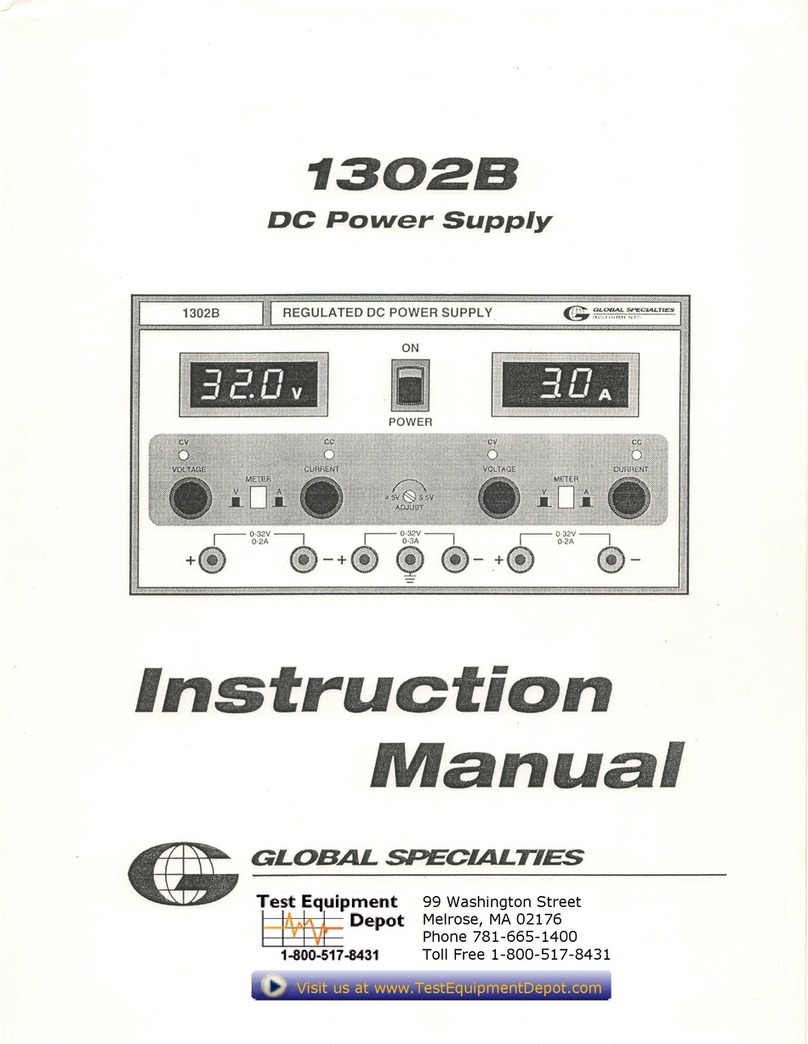
Global Specialties
Global Specialties 1302B User manual
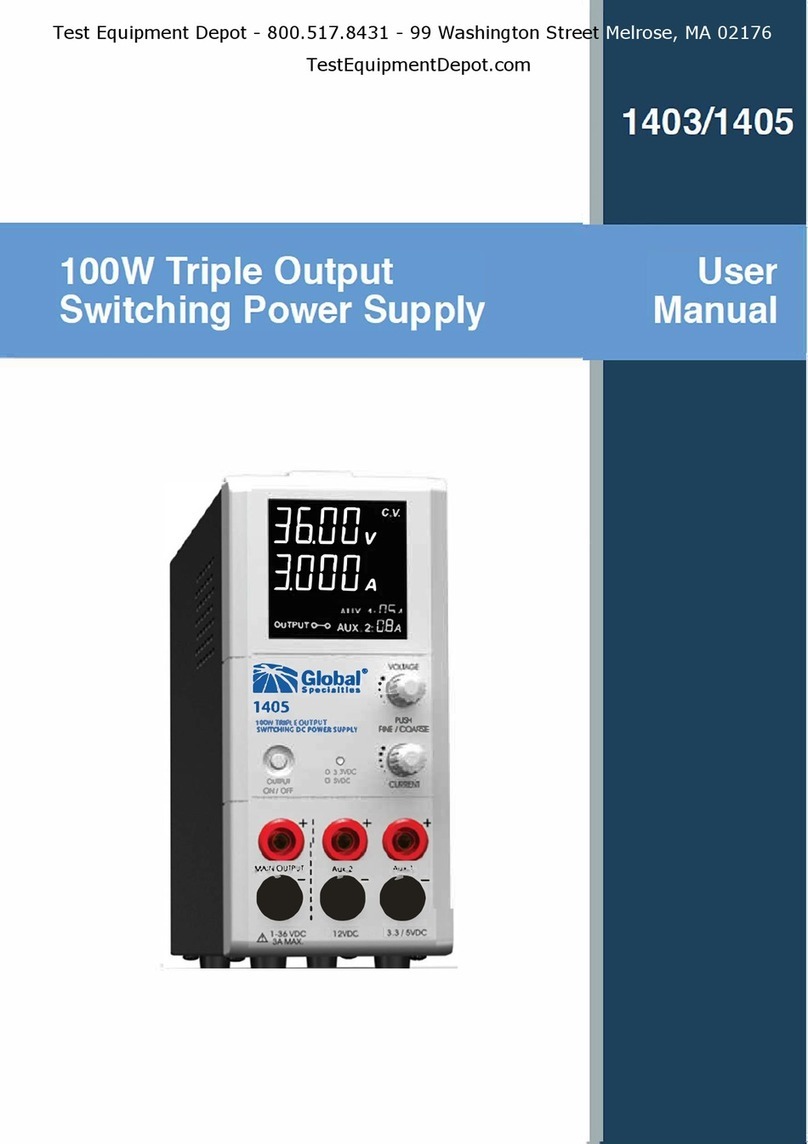
Global Specialties
Global Specialties 1403 User manual
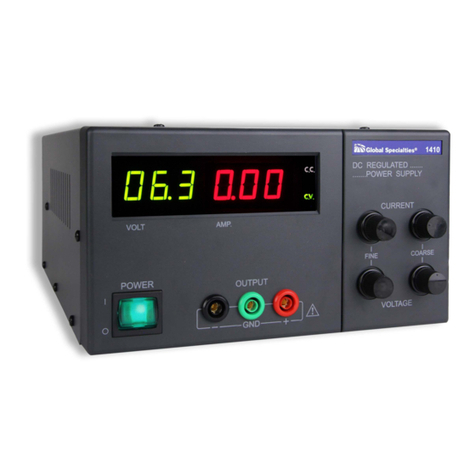
Global Specialties
Global Specialties 1410 User manual

Global Specialties
Global Specialties 1368 User manual

Global Specialties
Global Specialties 1505 User manual

Global Specialties
Global Specialties 1412 User manual
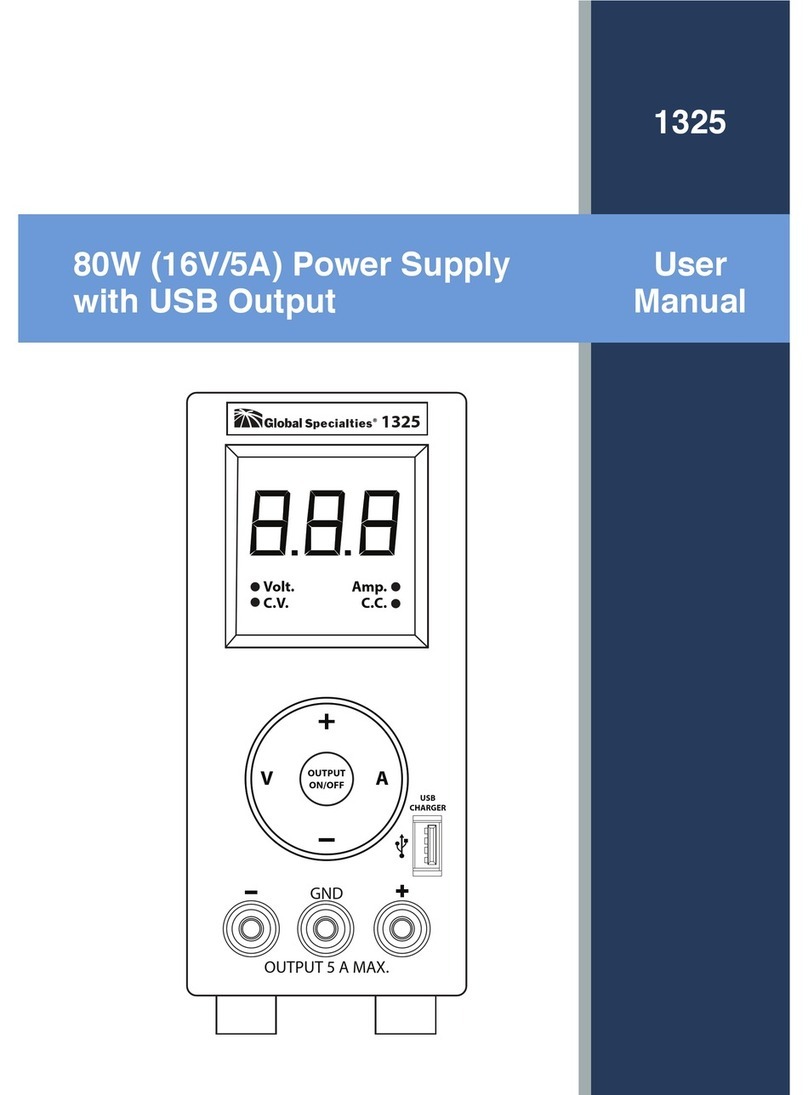
Global Specialties
Global Specialties 1325 User manual

Global Specialties
Global Specialties 1415 User manual
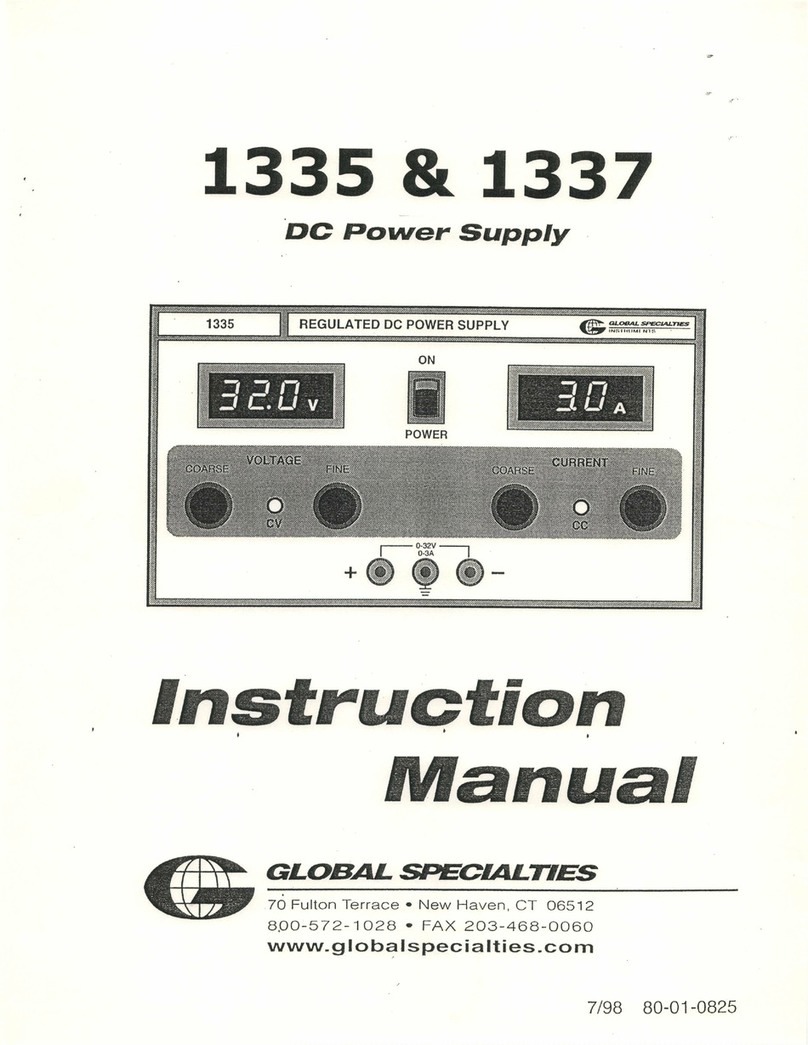
Global Specialties
Global Specialties 1335 User manual
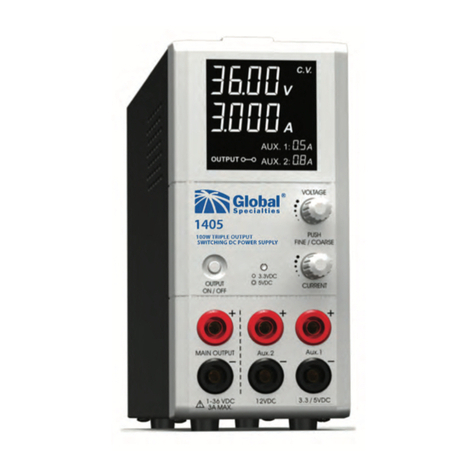
Global Specialties
Global Specialties 1403 User manual
